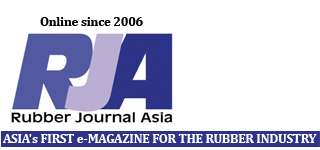 The accelerator molecule ETU (ethylene thiourea) has been used for more than 80 years in the vulcanisation of polychloroprene rubber as it facilitates the rubber cure system by speeding up the creation of molecular crosslinks, decreasing process duration and increasing physical properties. However, ETU is classified as a toxin and therefore, its use could be forbidden or restricted at some time in the future under the REACH regulations.
The accelerator molecule ETU (ethylene thiourea) has been used for more than 80 years in the vulcanisation of polychloroprene rubber as it facilitates the rubber cure system by speeding up the creation of molecular crosslinks, decreasing process duration and increasing physical properties. However, ETU is classified as a toxin and therefore, its use could be forbidden or restricted at some time in the future under the REACH regulations.
Since June 2010, the SafeRubber research project, funded by the European Commission, has been working on a suitable and safer alternative to ETU. The initial work concentrated on research into the chemical mechanism of the vulcanisation of polychloroprene. This enabled the SafeRubber research consortium to design 12 alternative molecules which by applying QSAR evaluation techniques can be expected to be safer than ETU. These molecules have been synthesised at a 20 g scale to allow testing of their curing properties with polychloroprene compounds. The curing tests resulted in the identification of two suitable accelerator molecules with curing characteristics similar to ETU.
One of the molecules has been selected for being scaled up to an industrial process. It is also undergoing a validation testing programme with the SME rubber compounding and moulding companies which form part of the research consortium. The partners in the SafeRubber research consortium are: Assocomaplast, Italian Plastics and Rubber Processing Machinery and Molds Manufacturers’ Association; Federplast.be, Belgian Plastic and Rubber Products Association; BRPPA, British Rubber and Polyurethane Products Association; ETRMA, European Tyre and Rubber Manufacturers’ Association; Clwyd Compounders Ltd, UK.; Robinson Brothers Ltd., UK.; MGN Transformaciones del Caucho, S.A., Spain; Mixer S.p.A., Italy; Grand Synthesis Latvia Ltd.; UNIMIB, University of Milano-Bicocca, Italy; Norner Innovation AS, Norway; and MaTRI, UK. Materials Technology Research Institute.
The final results of the three-year research based project are expected to become available at the end of May 2013 on the project’s web site: www.saferubber.eu, and through dissemination activities by the consortium’s partners. The preliminary results have been presented by ETRMA, the European Tyre and Rubber Manufacturers’ Association, at the International Rubber Congress in Paris on March 22.
